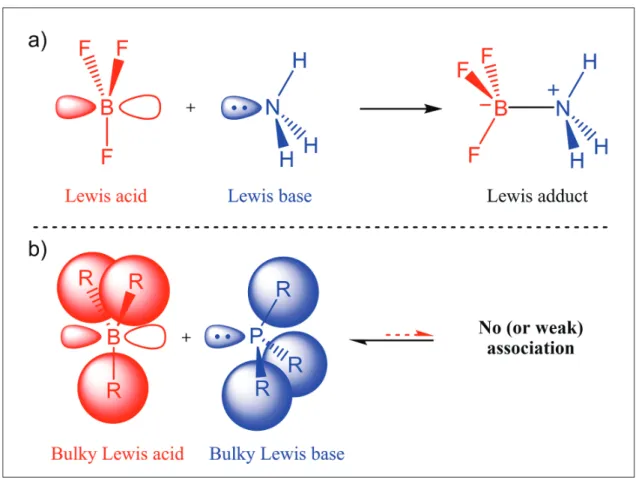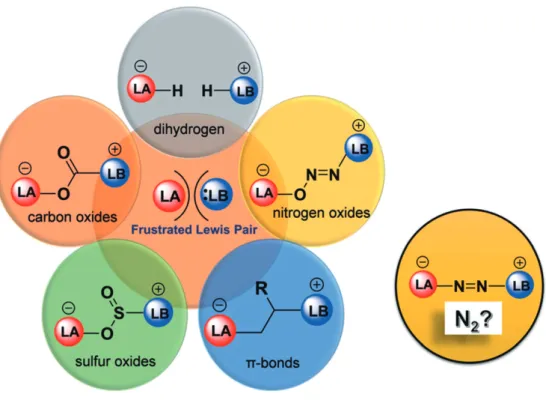RESEARCH OUTPUTS / RÉSULTATS DE RECHERCHE
Author(s) - Auteur(s) :
Publication date - Date de publication :
Permanent link - Permalien :
Rights / License - Licence de droit d’auteur :
Bibliothèque Universitaire Moretus Plantin
Institutional Repository - Research Portal
Dépôt Institutionnel - Portail de la Recherche
researchportal.unamur.be
University of Namur
Opening Up New Research Lines in Lewis Acid/Base Catalysis
Berionni, Guillaume; Hu, Lei; Ben Saida, Ali; Chardon, Aurélien; Gama, Mathieu; OSI, Arnaud; Mahaut, Damien; ANTOGNINI SILVA, Xavier
Published in: Chimie nouvelle
Publication date: 2018
Document Version
Publisher's PDF, also known as Version of record
Link to publication
Citation for pulished version (HARVARD):
Berionni, G, Hu, L, Ben Saida, A, Chardon, A, Gama, M, OSI, A, Mahaut, D & ANTOGNINI SILVA, X 2018, 'Opening Up New Research Lines in Lewis Acid/Base Catalysis' Chimie nouvelle, vol. 128, pp. 13-16. <http://chimienouvelle.be/Site%20chimie%20nouvelle/sommaire%20128.html>
General rights
Copyright and moral rights for the publications made accessible in the public portal are retained by the authors and/or other copyright owners and it is a condition of accessing publications that users recognise and abide by the legal requirements associated with these rights. • Users may download and print one copy of any publication from the public portal for the purpose of private study or research. • You may not further distribute the material or use it for any profit-making activity or commercial gain
• You may freely distribute the URL identifying the publication in the public portal ?
Take down policy
If you believe that this document breaches copyright please contact us providing details, and we will remove access to the work immediately and investigate your claim.
Catalyse
Opening up new research
lines in Lewis acid/base
catalysis
Opening up new research
lines in Lewis acid/base
catalysis
Guillaume BERIONNI*, Lei HU, Ali BEN SAIDA, Aurélien CHARDON, Mathieu GAMA, Arnaud OSI, Damien MAHAUT, Xavier ANTOGNINI SILVA
Namur Institute of Structured Matter (NISM) University of Namur, 61 rue de Bruxelles, B-5000 Namur, Belgium,
guillaume.berionni@unamur.be
Lewis acids and bases play an important role in modern chemistry and are extensively used in academic and industrial laboratories as catalysts, ligands, initiators, scavengers, etc. [1].
In general, Lewis acids and Lewis bases combine and undergo neutralization by forming a Lewis
adduct (Figure 1a) [2]. Steric bulk, however, prevents the formation of strong bonds between sterically hindered Lewis acids and bases (Figure 1b) [3].
13
Figure 1: a) Formation of a Lewis acid-base adduct between ammonia and boron trifluoride; b) Schematic representation of an intermolecular frustrated Lewis pair.
CHIMIE NOUVELLE N° 128 - octobre 2018 14
The resulting frustrated Lewis pairs (FLPs) with unquenched Lewis acid/base couples feature an unprecedented potential for cooperative activation of small molecules (H2, CO2, SO2, CO, N2O) [3]. Fascinated by the latest advances in the field of frustrated Lewis pairs catalysis [4], and with a longstanding interest in kinetic and mechanistic studies, we are interested in examining the fundamental chemistry of activation of small molecules (and of C-H bonds) by new types of Lewis acids and bases [5].
As a rational starting point, we are taking our inspiration from the seminal work of Wittig and Tochtermann on the reactivities of carbon and phosphorus-centred Lewis bases in combination with triphenylborane BPh3 (Figure 3) [6, 7]. As the C–B and P–B bonds of the Lewis adducts of Ph3C– and Ph
3P with the sterically hindered BPh3
Lewis acids are very weak, dissociation and subsequent reactions with a variety of substrates (ethers, alkenes [6] and 1,2-dehydrobenzene (benzyne)[7]) have been observed.
In sharp contrast, triphenylborane is completely associated with the ring strained triptycyl anion (Figure 4), which is more compact and basic than the trityl anion, and the resulting Lewis
adduct is even air and water stable [8]. Triptycyl-lithium is also spontaneously carbonylated by CO2 at low temperatures [9].
In view of the intense current interest in the development of sterically hindered Lewis bases [10], we are re-investigating the potential of the triptycyl anion and of the structurally related phospha [11] and aza-triptycenes [12] Lewis bases (Figure 5) as constituent of frustrated Lewis pairs in our research group.
A deep understanding of their reactivities will be obtained by performing NMR and spectrophotometrical binding titrations experiments with a series of Lewis acids of variable sizes and strengths (BF3, BPh3, B(C6F5)3). Comparison of their stereoelectronic properties (Tolman cone angle q and electronic parameter [13], pKa, Lewis basicity…) with those of classical and hindered phosphines will shed light on the potential applications of these triptycene-derived Lewis bases in FLPs catalysis.
These projects are synthetically challenging and expose our graduate and undergraduate students
Opening up new research lines in Lewis acid/base catalysis 15
Figure 3: Early examples of reversibly formed Lewis adducts reacting with the p-bonds of 1,3-butadiene (top) and benzyne (bottom) [6, 7].
Figure 4: Irreversible association of triptyc-9-yl lithium with CO2 and BPh3 [8, 9].
Figure 5: Examples of understudied carbon, nitrogen, and phosphorus Lewis bases.
to a variety of advanced synthetic, spectroscopic, photophysical and computational techniques. For these purposes, we have been developing collaborations with our skilled colleagues in computational chemistry, crystallography,
materials and organic chemistry at the University of Namur, and are open to broad scientific discussions with anyone interested in these research areas.
CHIMIE NOUVELLE N° 128 - octobre 2018 16
Acknowledgments
We acknowledge the University of Namur, the Namur Institute of Structured Matter (NISM) and the FNRS (2018-2020 MIS grant for GB) for generous funding. We thank N. Tumanov and J. Wouters for expertise in crystallography and B. Champagne for expertise in computational chemistry. We thank the Unité de Chimie Organique team (Prof. S. Vincent, Prof. S. Lanners) for useful discussions.
Author biography
Prof. Guillaume Berionni received his PhD from the University of Versailles (Institut Lavoisier de Versailles) in 2010 for his research on physical organic and supramolecular chemistry under the supervision of Prof. F. Terrier and R. Goumont. In 2010 he moved to the Ludwig Maximilian University of Munich as a Humboldt postdoctoral fellow under the guidance of Prof. Herbert Mayr and Prof. Paul Knochel. His post-doctoral and subsequent independent research on organometallic and organoboron chemistry has been supported by the Alexander von Humbolt and the DAAD foundations.
Since end 2017 he is Professor of organic chemistry at the University of Namur (Belgium) where he is managing a research team of 3 PhD students, a post-doctoral fellow, a technician and several master students. He is also actively involved in teaching, especially at the master’s level. In 2018 he received an incentive grant for scientific research (MIS grant 2018-2020) from the FNRS.
[1] J. R. Lawson, R. L. Melen, Inorg. Chem. 2017, 56, 8627.
[2] W. B. Jensen, Chem. Rev. 1978, 78, 1.
[3] For reviews on frustrated Lewis pairs, see: a) D. W. Stephan, G.
Erker, Angew. Chem. Int. Ed, 2015, 54, 6400; b) D. W. Stephan,
Science, 2016, 354, 1248.
[4] R. L. Melen, Angew. Chem. Int. Ed. 2017, 57, 880.
[5] a) E. Follet, P. Mayer, D. S. Stephenson, A. R. Ofial, G. Berionni,
Chem. Eur. J. 2017, 23, 7422;
b) E. Follet, P. Mayer, G. Berionni, Chem. Eur. J. 2017, 23, 623; (c)
V. Morozova, P. Mayer, G. Berionni, Angew. Chem. Int. Ed. 2015,
54, 14508.
[6] W. Tochtermann, Angew. Chem. Int. Ed. Engl. 1966, 5, 351.
[7] G. Wittig, E. Benz, Chem. Ber. 1959, 92, 1999.
[8] G. Wittig, W. Tochtermann, Justus Liebigs Ann. Chem. 1962, 660,
23.
[9] Y. Kawada, H. Iwamura, J. Org. Chem. 1981, 46, 3357.
[10] For selected examples, see: (a) L. Chen, P. Ren, B. P. Carrow, J. Am.
Chem. Soc. 2016, 138, 6392; (b) K. Banert, M. Heck, A. Ihle, J.
Kronawitt, T. Pester, T. Shoker, J. Org. Chem. 2018, 83, 5138.
[11] G. Wittig, G. Steinhoff, Chem. Ber. 1964, 676, 21.
[12] C. Jongsma, J. P. De Dekleijn, F. Bickelhaupt, Tetrahedron, 1974,
30, 3465.
[13] C. A. Tolman, Chem. Rev. 1977, 77, 313.
[13] Gillespie, D. T., Annu. Rev. Phys. Chem. 2007, 58, 35–55.
References
From left to right: Mathieu Gama - Guillaume Berionni - Aurélien Chardon - Xavier Antognini Silva - Damien Mahaut – Arnaud Osi - Lei Hu – Ali Ben Saida


![Figure 3: Early examples of reversibly formed Lewis adducts reacting with the p -bonds of 1,3-butadiene (top) and benzyne (bottom) [6, 7].](https://thumb-eu.123doks.com/thumbv2/123doknet/14502054.719442/4.892.92.805.128.428/figure-early-examples-reversibly-adducts-reacting-butadiene-benzyne.webp)